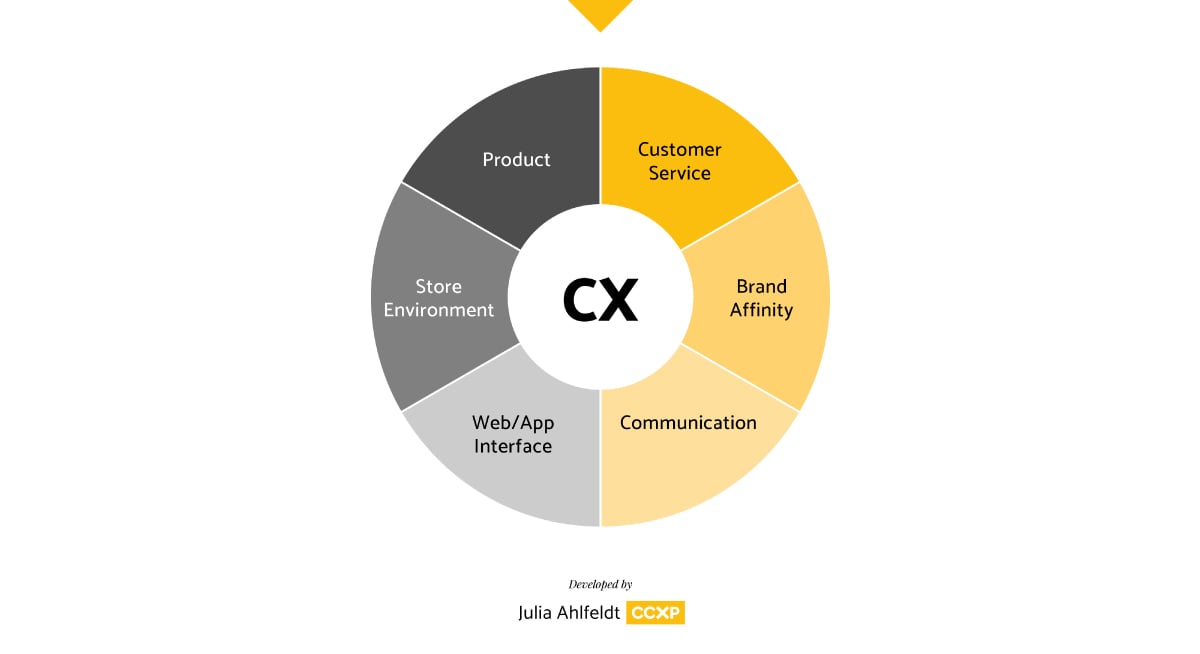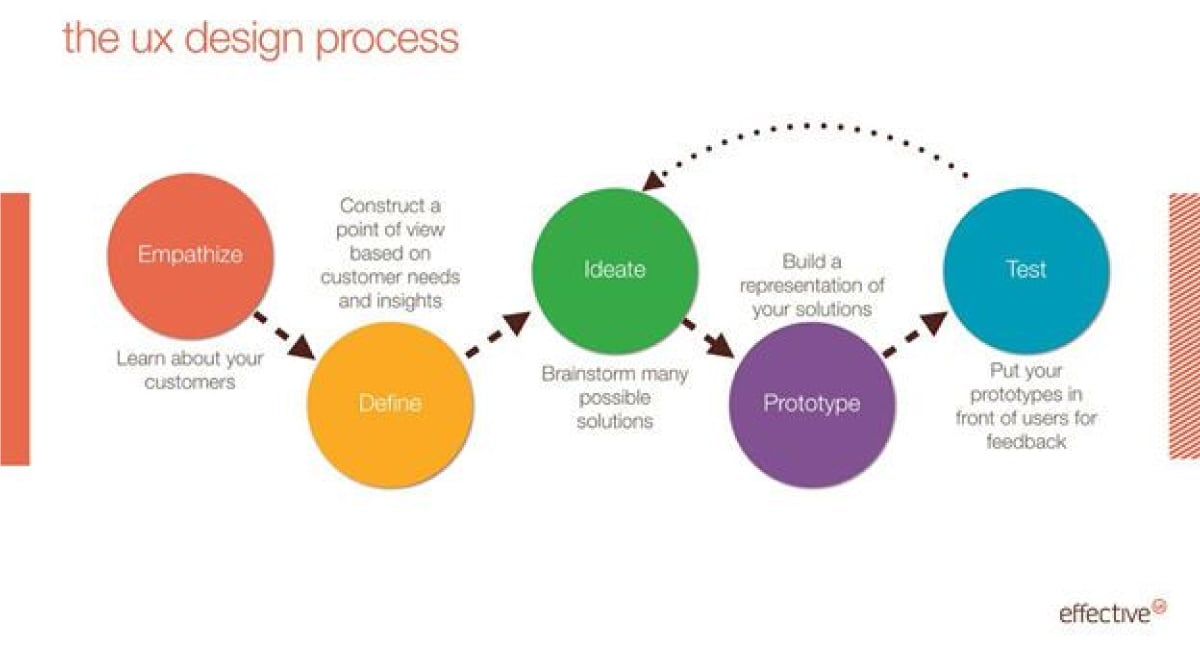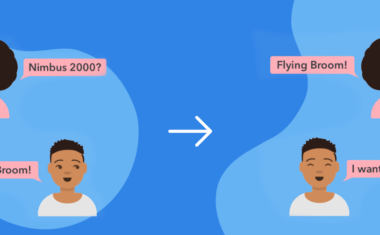Free UX Design Course
Dive into UX design with our free starter course. Transform your creative ideas into user-friendly solutions.
It’s easy to see why so many people confuse the terms customer experience (CX) and user experience (UX). These terms describe seemingly identical roles, and both roles are concerned with the experience of buying or and using a product or service.
But in actuality, these two terms denote very different roles. Confused? You aren’t alone. That’s why we’ve created this guide. To help clear things up, we’ve compiled a guide on the definitions, processes, and professions tied to the terms UX and CX.
Is There a Difference Between User Experience (UX) and Customer Experience (CX)?

Yes. User experience (UX) is concerned with how a user interacts with a digital product. Customer experience (CX), on the other hand, is concerned with a customer’s experience of the brand writ large.
Definition
To begin, let’s take a closer look at the definitions of each term.
What Is User Experience (UX)?

According to the man who coined the term in 1994, user experience was first used to describe the entirety of a user’s experience with a product, from start to finish. However, as the tech industry has evolved, the usage of UX has narrowed, and now often refers to the usability of a product.
The term has a close connection to UI (user interface), and is most commonly used with software and other products with a digital interface.
What Is Customer Experience (CX)?

First appearing just one year after UX in an essay by Lou Carbone, customer experience is a term that encompasses all elements of a consumer’s experience with a retail company.
From initial advertisements and the buying process to delivery and customer support, there are many components other than the product itself that make up the customer experience.
Goals
Another way to understand the difference between UX and CX is to study the goals they work towards.
UX Goals

For a UX designer, many of their goals and responsibilities revolve around the usability of the product. Some of those goals include:
Creating a Seamless, Intuitive, and Smooth User Experience
Digital interfaces and software products are used by many people who don’t know how they are made. To create a good UX, designers need to develop a product that can be used easily and intuitively by any kind of person.
Understanding a User’s Needs and Expectations
The creator’s intentions for a product and the user’s needs and expectations of it are not always in agreement. Through research and testing, designers aim to understand what the user wants and meet their needs through the UI and UX.
Reducing User Effort
In UI design, the concept of KISS (keep it stupid simple) highlights the need for simple interfaces. In the consumer industry, it’s important to minimize the time and effort your product costs a customer in order to keep them satisfied and willing to use your products again.
Accessibility
Making a product accessible to as many groups of people as possible widens the potential target audience.
Allowing the User To Be in Control
A goal of UX is to help the user feel in control, rather than being shut down by error messages and unintuitive menus and interactions.
User Satisfaction
The primary aim is to satisfy the customer with a quick, easy, and fun-to-use product.
Get To Know Other Design Students
Kashif Ross
UX Analyst at Circulo
Miranda Mason
Springboard X Blacks In Technology Fellow at Springboard
Micole Simpson
UX Designer at Skipify
CX Goals
CX designers aim to increase overall satisfaction with the company and maximize retention. Here’s what that looks like in action:
Ensuring That Customers Have an Enjoyable Brand Interaction Across All Touchpoints and Platforms

This involves overseeing advertising campaigns, social media campaigns, customer support, packing and delivery, user manuals and tutorials, and many other areas.
Improving Customer Satisfaction

A CX designer will work towards this goal by refining the areas mentioned above and making sure no part of the buying process detracts from the quality of the product.
Increasing Customer Retention and Customer Lifetime Value
Once a customer is satisfied with their initial purchase, they will be more likely to buy from the company again.
Reducing Churn
For products and services with memberships and subscriptions, CX departments aim to minimize cancellations.
Boosting Customer Loyalty
By developing a quality customer experience, CX designers can build customer loyalty and encourage customers to choose their company again without even looking into other options.
Process
The differences between UX and CX also extend to their processes.
UX Process

The UX design process works closely with the product development team and UI designers. Here are the steps that designers take to make that happen:
Empathize
Consider the position and thoughts of the user when faced with the product for the first time.
Define
Define the needs of the user, the goals of the product, and the fundamentals of the UI design.
Prototype
Create wireframes and prototypes that can be used and tested by colleagues and testers.
Ideate
Develop and improve the usability of the product according to feedback.
Test
Carry out further tests and implement improvements until the final product is formed.
CX Process

The CX process begins earlier and involves more research into the customer base. It often goes as follows:
Customer Research
Research the target audience—what they want, what kinds of advertisements they are receptive to, their budget range, and more. etc.
Develop Your Customer Personas
Customer personas help CX designers empathize and discover the finer details of what a customer needs and why.
Map Out the Customer Journey
Following a potential customer’s journey helps highlight flaws and gaps in the customer experience.
Develop Your Messaging
Collaborate with the marketing department to help ensure advertising is in agreement with the CX research.
Build Prototypes and Collect Feedback
Collect feedback on product prototypes and implement improvements.
Bring to Market, Learn, and Refine
Even after a product goes on sale, learn from the successes, failures, and feedback to and continue to refine the customer experience.
Metrics Used To Measure Success
While both UX and CX aim for “customer satisfaction,” they measure success in different ways.
UX Metrics
UX metrics for success include:
Conversion Rate

Customer conversion rates evaluate the effectiveness of marketing and advertising strategies by measuring the number of website visitors that perform a certain conversion action. The type of action depends on your business needs, but often includes becoming a member, signing up for a newsletter, making a purchase, or contacting the company.
Time Spent On A Particular Task And Task Success Rate

To assess the quality of user interfaces and user journeys, the amount of time customers spend on a task and how often they succeed in their objective are recorded and analyzed. If the time spent is high and success is low, then your system is likely too complicated or lacks clarity.
System Usability Scale

SUS (System Usability Scale) is another way to measure the effectiveness of user interfaces. The 10-item questionnaire asks customers to evaluate their experience with the system based on ease of use, lack of complexity, and other factors.
Bounce Rate

Bounce rate is the opposite of conversion rate–it measures the number of website visitors that leave the page without taking any action.
A/B Test Results

A/B test results allow UX design teams to see which of two versions of a product performed better in a test–for instance, which version of a newsletter achieved better conversion rates. This testing method allows teams to test out multiple ideas and improve their numbers.
CX Metrics
To measure CX successes, the following metrics are used:
Net Promoter Score

Your NPS (Net Promoter Score) is calculated based on customer responses to a single question: how likely is it that you would recommend [brand] to a friend or colleague? This metric is used to determine the percentage of detracting, passive, and promoting customers your business has gained.
Retention Rate

Retention rate shows how many customers a company is able to keep over a certain period of time. For instance, how many customers keep their membership active for a full year, compared with how many canceled during that year? It helps companies know when they are on the right track, and when they need to make changes to keep customers for longer.
Customer Lifetime Value

This metric measures how much value a customer brings to the business during the entirety of the relationship. In a lot of cases, this means measuring how much money each customer spends or how many purchases they make overall. If the lifetime values are low, a company may invest in some upselling campaigns to get their current customers to buy more.
Brand Recognition And Recall

These metrics are a way to measure brand awareness, simply by testing how easily customers can remember the name of your brand. Some companies are influential enough to never be forgotten, which helps sustain their popularity in a number of ways.
Customer Effort Score

Customer effort scores (CES) can be used to evaluate the customer service and user systems in place at a company by measuring the amount of effort a customer had to exhaust to achieve their objective. The CES questionnaire typically asks the question: on a scale of “very easy” to “very difficult,” how easy was it to interact with [brand]?
Real-Life Examples of Great UX and CX
UX Examples
Let’s look at some examples of great UX design:
Squarespace

Squarespace is a website-building service that minimizes effort and maximizes accessibility. Website templates allow users to create their sites quickly and easily, and eliminating the need for coding opens up the service to many more people.
Wolt

Wolt is an online delivery service that keeps the user up to date with every step of the process. The app sends notifications to let the user know when a human has seen their order and when it has been accepted, as well as showing exactly where the courier is at all times. All of this puts the user at ease and makes their experience as smooth as possible.
CX Examples
Some good examples of CX design include:
Apple Store

When a customer enters an Apple store, they will be instantly greeted by one of the many Apple “Geniuses.” These well-informed store clerks are stationed all over the shop and can complete purchases with their payment tools right on the spot.
This structure means that every customer gets one-on-one time with someone that can answer their questions, and no one will leave the shop wondering if they bought the right thing or if they missed out on an opportunity.
UNIQLO Self-Checkout
UNIQLO focuses on quality everyday clothing, with ample choice in colors and styles, and a self-checkout machine that has you out the door in seconds.
To buy clothing at a UNIQLO store, all you have to do is place all your items into the scanning area, and the machine will do all the rest. Without having to scan a single barcode, your items will be instantly counted and scanned, and your bill ready to be paid with contactless or card payment. This quick system reduces the effort for the customer and minimizes queue times.
The Profession: Roles, Responsibilities, Skills, and Salary

The roles of UX designer and CX designer have many similarities, but they are often focused on different elements of the product development process.
UX Designer

A UX designer collaborates with product development teams to ensure the optimum usability of a product.
Responsibilities
The responsibilities of a UX designer include:
- Conduct User Research
- Design Prototypes and Wireframes
- Create And Improve User Flows
- Testing and Iterating
Average Salary

The average yearly salary for a UX designer is $96,977 in the United States. With experience, this can increase to as much as heights of $129,033.

Skills Needed
Some common skills companies look for in a UX designer include:
Technical Skills
- Knowledge of design fundamentals
- Creating wireframes and prototypes
- Experience with UX design tools such as Adobe InDesign
- Research skills
Soft Skills
- Communication
- Collaboration
- Empathy
- Organization
CX Designer

A customer experience designer focuses on defining a customer’s needs and finding ways to meet these needs through the buying process.
Responsibilities
To achieve this, a CX designer is responsible for:
- Conduct Customer Research
- Create and Implement CX Strategies
- Develop Customer Journey Maps
- Design CX Touchpoints
- Analyze Customer Feedback
- Optimize Processes And Continuous Improvement
Average Salary

For CX designers, salaries average at around $104,467. On Glassdoor, senior CX designers have reported salaries as high as $430,000 per year.
Skills Needed
Here are some examples of CX designer skills.
Technical Skills
- Data collection
- User research skills
- Presentation skills
Soft Skills
- Communication
- Empathy
- Collaboration
- Management skills
UX vs CX: The Difference

Next, we’ll break down some of the key differences between UX and CX.
Basic Concept
UX designers focus on maximizing the usability of a specific product, while CX designers consider all the ways in which a customer experiences the brand.
Research
CX designers often deal with large groups of customers and users, while UX designers typically focus on user personas or specific groups of people.
Point of Interaction
CX designers deal with many touchpoints, such as websites, mobile interactions, advertising, the sales process, customer service, and customer support. A UX designer deals with customer interactions too but focuses on a particular product.
People Served
Customer experience leans more towards the people making the purchases, while user experience is geared more towards the people using the product.
Metrics
In UX, success is measured by how well and how easily the product is used. With CX, the focus is on customer retention, repeat business rates, and reviews.
UX vs. CX FAQs
We’ve got answers to some of your most frequently asked questions.
How Do CX and UX Work Together?
Although they can overlap in places, UX and CX work in different areas to improve customer satisfaction as a whole. UX focuses on developing a quality product, and CX develops a quality service to sell and deliver the product.
Is UX a Subset of CX?
Yes. Delivering a quality digital product is part of delivering a quality customer experience. You can’t have a good customer experience without a usable product, but you can have a usable product without a good customer experience.
Which Is More Important: UX or CX?
Both areas are essential for companies to grow, improve, and increase profit. For a new company, perfecting the usability of your product might be the first priority, instead of perfecting the buying experience for a product that is not yet worthy of being sold.
Which Career Is Right for Me?
After reading through this article, you might have an idea of which area sounds more interesting to you. If not, the first thing to think about is whether you want to work more on the products, or more on the audiences that buy them.
Once you find something you want to learn more about, you can try out an online UI/UX bootcamp that can introduce you to all the skills you’ll need to know as a professional in experience design.
Since you’re here
If you want to work in design, you can. It’s that simple. With our UX Bootcamp, we’ll help you launch your design career in 9 months or less. Browse our free UX salary guide to see what you could be making









